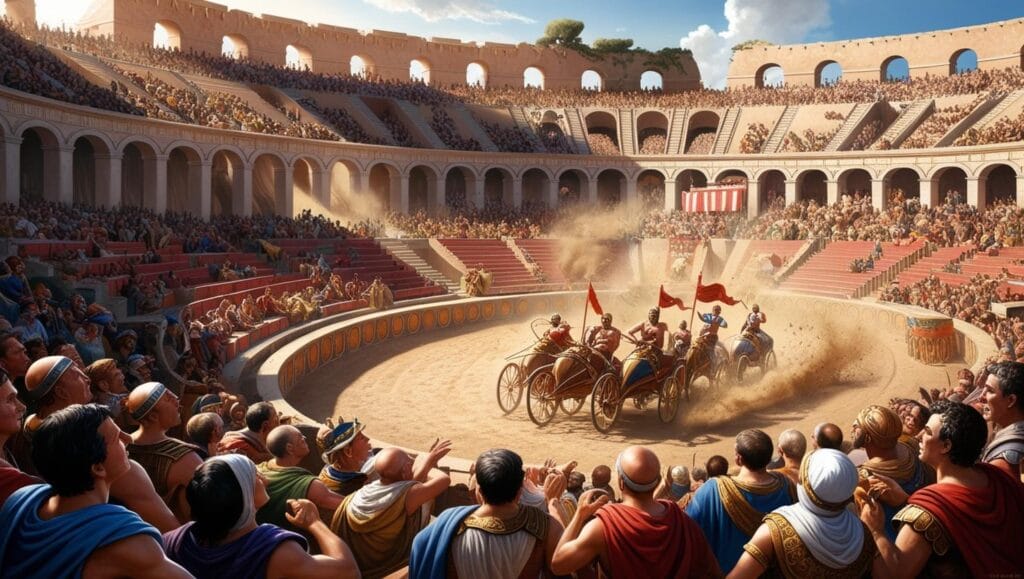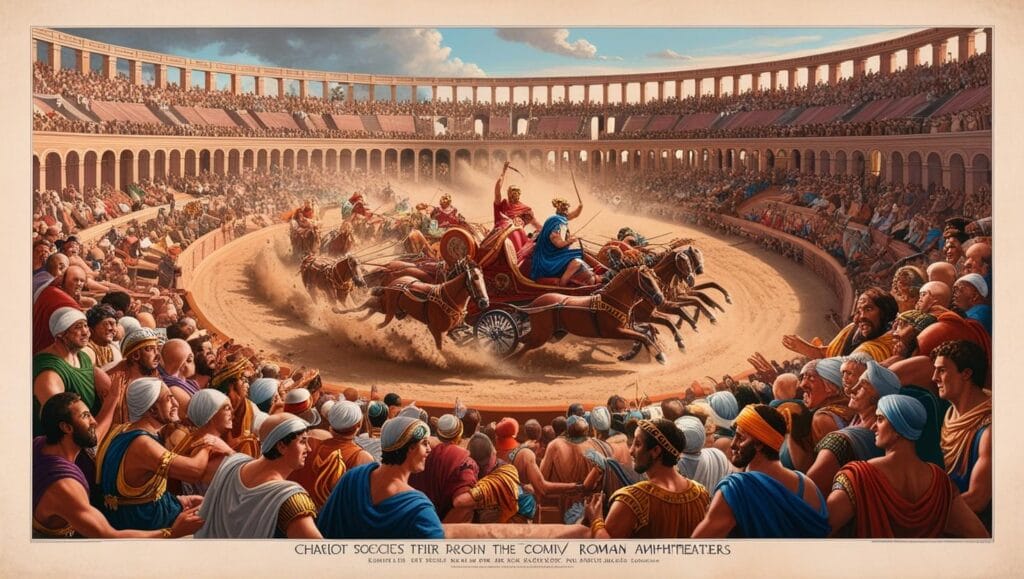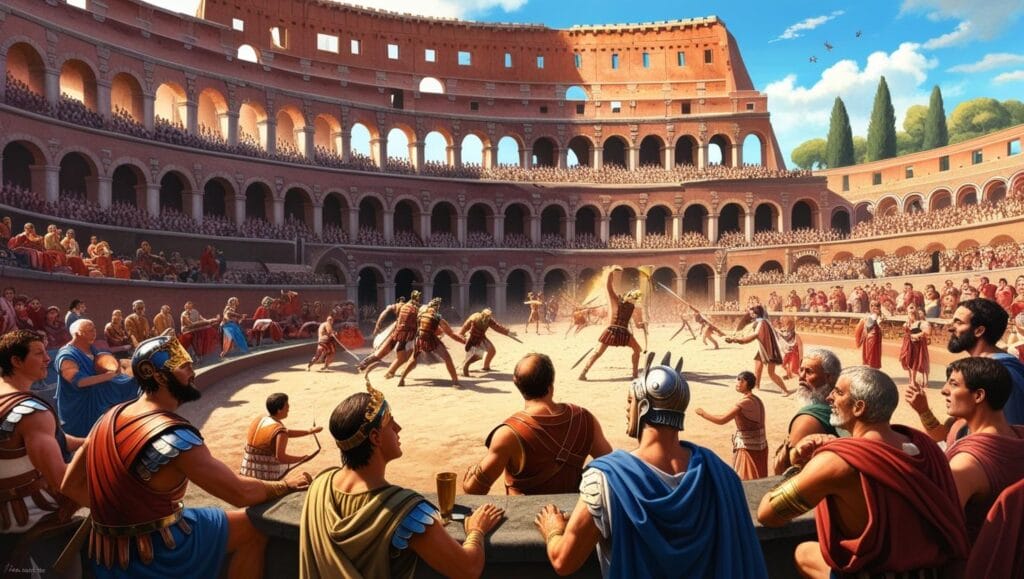In ancient Rome, the concept of ‘bread and circuses’ epitomized the use of public entertainment as a tool for social control. These spectacles, ranging from gladiatorial games to theatrical performances, were integral to Roman life, offering both diversion and a display of state power.
Roman public spectacles served multifaceted purposes. Primarily, they acted as a distraction, entertaining the masses and diverting attention from societal issues. This strategy not only pacified the populace but also reinforced the sociopolitical hierarchy. The spectacles highlighted the authority of the ruling elite, who often sponsored these events to gain favor and enhance their political standing. Thus, public spectacles were a vital component in maintaining order and cohesion within Roman society.
By providing a common cultural experience, these events fostered a sense of unity, integrating diverse populations under the vast Roman Empire.
Types of Public Spectacles
Gladiatorial Games
Gladiatorial games were among the most iconic spectacles in ancient Rome, held in grand amphitheaters like the Colosseum. These combat events featured armed fighters, often slaves or prisoners, battling to the death. They were designed to display Roman power and control, drawing massive crowds for thrilling entertainment.

Chariot Races
Chariot races were another popular form of public spectacle, taking place in massive venues like the Circus Maximus. These high-speed competitions involved teams of horses pulling chariots around a track, offering excitement and danger. The races captivated audiences and served as a means of showcasing wealth and status among the elite sponsors.
Theatrical Performances
Theatrical performances in Roman society evolved from Etruscan traditions, later incorporating scripted plays and elaborate productions. These performances, hosted in purpose-built theaters, were known for their enclosed structures and strict audience segregation. They not only entertained but also reinforced social hierarchies and communal values. Through these spectacles, Rome celebrated its cultural diversity and integrated various influences from conquered territories.
Political Strategy Behind Spectacles
In ancient Rome, the strategic use of public spectacles served as a crucial tool for maintaining social order. Roman authorities recognized that by offering free entertainment, such as gladiator games, chariot races, and theatrical performances, they could effectively distract the populace from pressing political issues and potential unrest. These events were not merely for leisure but were carefully orchestrated to divert attention away from the empire’s underlying challenges, including political corruption and economic struggles.

The concept of ‘bread and circuses’ was central to this strategy, as it combined entertainment with the distribution of free grain through programs like the ‘Annona’. This ensured that citizens’ basic needs were met, reducing the likelihood of dissatisfaction that could lead to organized dissent. The emperors played a vital role in this approach, as their presence at these spectacles reinforced their power and authority, further dissuading any potential rebellion. By keeping the masses engaged and content, Roman leaders effectively maintained political compliance and stability, securing their control over the vast empire.

Reinforcing Social Hierarchies
The organization of seating during public spectacles in ancient Rome vividly illustrated the prevailing social hierarchies of the time. The Ima Cavea, reserved for the Emperor, Senators, and Vestal Virgins, was an exclusive area highlighting the status of Rome’s elite. Senators enjoyed personalized seats with their names inscribed, underscoring their prominence within society.
Below them, the Maenianum Primum accommodated the equites, a class positioned just below the senators. Ordinary citizens and plebeians occupied the Maenianum Secundum Imum, while poorer plebeians were relegated to the Maenianum Secundum Summum. Finally, the Maenianum Secundum in Ligneis housed the lowest classes and slaves. This meticulous arrangement accentuated the distinct social stratification.
Such structured seating not only reinforced existing class divisions but also served as a mechanism of societal control. The arrangement ensured that everyone was constantly reminded of their place within the hierarchy, effectively maintaining the status quo. By clearly delineating social boundaries, these spectacles emphasized the superiority of the elite, while simultaneously providing a controlled environment for the masses to experience communal entertainment.
Unity Amidst Diversity
In the grand arenas of ancient Rome, public spectacles such as gladiatorial games, chariot races, and theatrical performances played a pivotal role in uniting diverse social groups. These events were held in magnificent venues like the Colosseum and Circus Maximus, capable of accommodating thousands of spectators, which fostered a shared experience among attendees. In these vast spaces, individuals from all walks of life—patricians, plebeians, and slaves—converged, temporarily diminishing social barriers and creating a unique communal environment.

The shared excitement and emotional investment in these spectacles cultivated a collective identity among spectators. The communal cheers, gasps, and reactions to the events reinforced a sense of belonging, transcending individual social status. Such shared experiences were crucial in promoting unity, as they allowed citizens to engage with one another and reaffirm shared values and cultural norms.
Moreover, these spectacles were imbued with cultural significance. They often incorporated elements of Roman culture and mythology, strengthening a common cultural identity among the audience. This cultural layer not only entertained but also offered a platform for citizens to collectively embrace their heritage, thereby reinforcing a sense of unity and belonging within the diverse fabric of Roman society.
Bread and Free Food
The concept of ‘bread and circuses’ is deeply rooted in the strategic distribution of food, particularly bread, to maintain public morale in ancient Rome. Bread served as a vital staple in the diet of plebeians, the common citizens, who primarily relied on simple meals. The Roman authorities, recognizing the importance of bread in daily life, used it as a tool to pacify the populace.

Through public spectacles, such as games and festivals, the government provided free food to the masses. This practice of food distribution was not merely an act of generosity but a calculated political strategy. By offering sustenance alongside entertainment, rulers ensured that citizens remained content and less likely to engage in political dissent.
Historical anecdotes reveal that during events at the Colosseum, distribution of bread and other food items helped distract the populace from dissatisfaction with their governance. This approach effectively kept the masses complacent, as they prioritized immediate pleasures over civic responsibilities. Thus, bread, in this context, became a symbol of control, reinforcing the power dynamics between the ruling class and the common people.
Social Order and Stability
In ancient Rome, public spectacles played a pivotal role in maintaining social order and stability. By offering a combination of food and entertainment, the Roman authorities managed to pacify the populace effectively. This practice, known as ‘bread and circuses,’ was instrumental in preventing revolts and curbing potential unrest.

Through events such as gladiatorial games and chariot races, rulers distracted citizens from political dissatisfaction. These spectacles were more than mere entertainment; they served as tools for social control. By keeping the masses engaged, the government reduced the likelihood of civil disobedience.
Historical evidence suggests that these events not only entertained but also reinforced social hierarchies. The seating arrangements in arenas, based on class and status, reflected and maintained the existing power dynamics. This strategic organization of public spectacles ensured that citizens remained occupied with immediate pleasures, thereby diverting their attention away from governance issues.
Overall, the Roman approach to managing social order through spectacles was highly successful. It illustrates how well-crafted distractions can foster societal stability, a tactic that still finds relevance in contemporary political strategies.
Modern Parallels
The concept of using public entertainment as a means of distraction is not confined to ancient Rome. In contemporary society, many forms of public entertainment serve a similar purpose. Professional sports, for instance, often capture the collective attention of millions, providing a diversion from pressing societal issues. Events like the Super Bowl or the Olympics command vast audiences, drawing focus away from political concerns and creating temporary unity among diverse populations.

Similarly, reality television shows and blockbuster films offer escapism that can overshadow more serious matters. These forms of entertainment can function as political distractions, steering public discourse away from critical debates on governance and public policy. While they entertain, they also occupy the public’s attention, much like the spectacles of ancient Rome.
In both historical and modern contexts, these distractions can reinforce existing power structures by keeping the populace engaged with superficial pleasures. This strategic use of entertainment underscores the enduring power of spectacle, illustrating its role in maintaining social order across centuries.
Data and Statistics
Quantitative analysis of Roman spectacles reveals their considerable impact on society. Estimates suggest that the Colosseum could accommodate up to 50,000 spectators, offering free entertainment to the masses. These events, like gladiatorial games, were held frequently, with some accounts indicating that hundreds of thousands of animals and participants were involved over time.

In comparison, modern public spectacles such as the Super Bowl attract millions of viewers worldwide, with an estimated 100 million television viewers in the United States alone. The scale of these events demonstrates the continued role of entertainment in capturing public attention.
| Aspect | Roman Spectacles | Modern Spectacles |
|---|---|---|
| Venue Capacity | Up to 50,000 (Colosseum) | Over 100,000 (Stadiums) |
| Frequency | Regular, often weekly | Annual or biennial |
| Viewership | Local populace | Global audience, millions |
This comparison highlights the enduring significance of public spectacles as tools for distraction and social cohesion. Both ancient and modern spectacles serve to divert attention and promote a shared cultural experience, reinforcing societal structures through entertainment. These data-driven insights underscore the parallels between Roman and contemporary public spectacles.

Conclusion
In ancient Rome, public spectacles such as gladiatorial games, chariot races, and theatrical performances played a pivotal role in maintaining social order. By providing entertainment and distributing food, Roman authorities effectively distracted the populace from political issues and potential unrest. These spectacles reinforced social hierarchies through strategic seating arrangements while simultaneously fostering a sense of unity among diverse social groups.
The legacy of Roman spectacles endures in today’s society, with modern forms of entertainment often serving similar functions in distracting and uniting the public. Although specific parallels with contemporary examples were not detailed in the sources, the enduring nature of public spectacles highlights their historical significance as a tool for social cohesion and political strategy.

Frequently Asked Questions
Q: What were the primary types of Roman spectacles?
A: The main types of Roman spectacles were gladiatorial games, chariot races, and theatrical performances. These events were designed to entertain the masses and maintain social order.
Q: How did Roman spectacles reinforce social hierarchies?
A: Seating arrangements at these events were based on class and social status, reinforcing the existing social hierarchy. The elite enjoyed premium seating, while the lower classes were seated further away.
Q: Did Roman spectacles serve a political purpose?
A: Yes, they distracted the public from political issues and potential unrest. By providing free entertainment and food, emperors could maintain peace and stability.
Q: Are there misconceptions about the role of Roman spectacles?
A: A common misconception is that these spectacles were solely for entertainment. In reality, they also played a critical role in political strategy and social control.
These frequently asked questions highlight the significance and multifaceted role of public spectacles in ancient Roman society.

